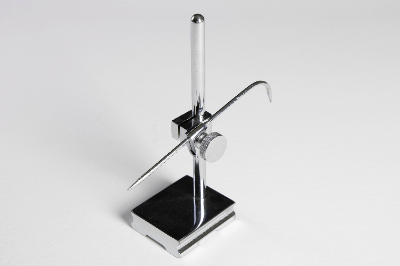What Is a Tuscan?

The tuscan is a tool that draws a bevel line on a workpiece at a height parallel to the base surface of a surface plate or other base surface.
It is also used for rough centering when gripping black leather material in a general-purpose lathe’s 4-jaw chuck, etc. An arm with a beveling section is fixed to an upright base, and the beveling section can be adjusted to any height.
The marking section is equipped with a marking needle made of high-speed steel or other material that scratches the workpiece, a pencil, and a mechanical pencil. The tuscan is used for marking work, which requires skilled tousling work since the marking method varies depending on the specification conditions.
Uses of Tuscans
Tuscans are used to perform manual processing processes that do not rely on machines. The main purposes of tuscan-based grading operations are as follows:
- Draw dimensions and shapes on workpieces according to drawing specifications
- Draw horizontal, vertical, circle, and center lines
- Punching for drilling operations
When it is difficult to work accurately with just the instructions on the drawing, using a tuscan to define the reference line allows for more precise work. For example, when determining welding points, supplying a workpiece that has been previously beveled can prevent misalignment during welding operations.
Tuscans are also useful when determining the center of a round bar. While rotating the round bar, draw four parallel lines on the surface plate using the tuscan, then connect the opposite vertices to find the intersection point, which is the center of the round bar.
Tuscans are used not only for metalworking but also for making stars for sculptures and plastic models.
Principle of Tuscans
The tuscan has an arm extending from a metal fitting mounted perpendicular to the base, and the arm is held at a height and angle that makes it easy to work with the workpiece. A needle or pen is attached to the end of the arm to draw directly on the workpiece.
When drawing a beveled line on the workpiece, the tuscan is not moved but slides over the workpiece. Therefore, it is necessary to have the skill to place the tip of the arm on the workpiece firmly and without any misalignment.
In addition, the type of needle or pen to be attached to the tip of the arm is also important. For example, burning the tip of a needle will allow you to put in a more secure keg line. If a pencil is attached, it can erase mistakes and is also useful for drawing horizontal lines on uneven objects without damaging the material.
The method of marking varies depending on the specification conditions. In addition, the needle at the tip that hits the workpiece requires a high degree of sophistication and wear resistance. In center positioning work, one side of the needle may be bent at a 90-degree angle.
Other Information About Tuscan
1. What Is Roughing Out?
Tuscans are also used for centering operations in the 4-jaw chuck of general-purpose lathes. In this operation, tuscans are usually used for rough centering work in black leather material.
Centering is the process of minimizing the runout of the workpiece when the chuck is rotated. Centering is performed by placing the tuscan in contact with a point of high runout and rotating the chuck to check the clearance between the tuscan and the workpiece, and then adjusting the tightness of each jaw on the 4-jaw chuck to eliminate the clearance.
When centering a workpiece on a machined surface, a tuscan cannot be used because centering must be performed with a high degree of accuracy. In such cases, a dial gage is used instead of a tuscan to read the numerical value for centering.
2. What Is a Height Gauge?
Basically, a height gauge is a measuring instrument for measuring the height and thickness of a workpiece. The height and thickness of a workpiece can be measured by placing the measuring surface of the scriber against the top surface of the workpiece to be measured.
The tip of the scriber is sharp and can be used to draw a bevel line on a metal workpiece, etc. In this case, the height gage is used to measure the height and thickness of the workpiece. In this case, the height gauge plays the same role as a tuscan, allowing the scribe line to be drawn at a more accurate height.